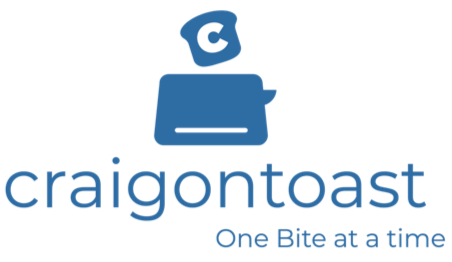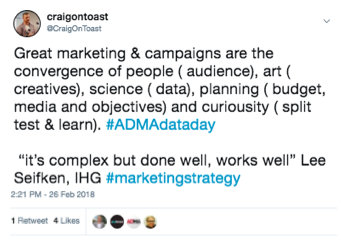ADMA Data Day 2018: Be Bold, Inquisitive and Experiment.
I was watching RuPaul’s Drag Race over the weekend ( Season 4, Ep 7 – Dragazines) and there was a really interesting moment when RuPaul, doing her usual rounds with the queens as they prepared for that week’s challenge (designing a dragazine cover, headlines and all) asked about the meaning behind them and the creative choices being made. They were basic questions really - “ Who is your dragazine for?”, “What does your dragazine say about you?”, “Why would someone want to buy your dragazine”? Sharon Needles responded to questions about her dragazine “Kitty Cat” by meowing, William defined his audience as “women… and men”- and Phi Phi O’Bitchface ( sorry, O’Hara) simply replied “ Oh Ru don’t you worry, I’m a graphic designer, I’ve got this”.
It was obvious that everyone had dived in without giving any thought to their “Why?” so there was no foundation for the decisions they were making. But why the fuck am I talking about drag queens when you came to read about ADMA Data Day? Ultimately the winner of the challenge was determined not by their great creative vision, or the execution of it, but because there had to be a winner, even though it was clear no one had a fucking clue what they were doing, or why.
Every cover was it’s own brand of awful. So awful that the best the judges could do was choose the least worst cover as the winner. What a drag.
Interestingly one of the key themes I saw threaded through all the presentations at Data Day reflected the type of questions RuPaul was asking, when building any type of strategy it’s important to always start with the basics. Business, marketing, content, social, CX, UX, campaign - at the core of any effective and strong strategy are 5 simple questions – who, what, where, when and why – but, like the Editor Queens, we often dive in without asking them properly, leaving us planning blindfolded, making it up, or creating unnecessary stress by asking them as we build. None of which is ideal.
Taking the time to go back to basics and dive into data to help us find the answers will save time, stress and money and reveal valuable stories, insights and gold, and it doesn’t even have to be hard. BT’s Head of Marketing, Karen Giuliani, talked through her 4 stages of Agile Content Marketing. Using data as the foundation to Discover, Define, Design and Deliver and Deep Dive, she showed us how to build effective personalized marketing and content strategies for a variety of mass audiences to deliver different growth objectives. BT’s strategies and approaches to do everything from engage young people in superannuation to retain existing retiree members were brilliant examples of how aligning business goals with a deep understanding of audiences to build marketing, digital, content, social and influencer strategies, driven by data of course, creates success.
I was however fascinated by the measurement model. Measuring soft metrics like reach, engagement - social media, edm open rates etc – and clicks while not measuring revenue, ROI and other “hard” metrics that genuinely impact and reflect business performance is a practice that marketers have to move on from.Inuit’s Wendy Walker wisely said during her session later in the day that “data is useless if you don’t do anything with it”. Arguably reach, shares, clicks and engagement are useless if consumers don’t do anything else with you.
Red Planet’s Vaughan Chandler took personalization and relevancy to the next level by analyzing the Data Day audience (us), well ADMA’s member database. By asking a few simple but purposeful questions he was able to identify wastage in member communications spend, opportunities to shift budget to drive stronger results and unexpected commonalities and trends in interests to leverage. Proof that there are valuable stories in data, you just have to take the time and effort to look for them.
Woolworth’s Director of Loyalty, Ingrid Maes, opened with her belief that "data is a precious gift" and discussed the value of leveraging familiarity and consumer habits to improve performance and revenue by influencing everything from the supply chain and distribution to store layout and shelf product placement. However before you can leverage them you have to identify them, and data is rich with not just the expectations and habits of your consumers, but unexpected ways to surprise and delight them and insights from the business, micro and macro environment that can help inspire and drive innovation.Used well, data can be the gift that keeps on giving.
IHG’s Director of Marketing Lee Siefken took the room on a journey of why marketing is an art, and great marketing is a combination art, data science and utilizing the magic of Facebook advertising to define, reach and engage new and existing IHG customers across Facebook and Instagram. “Travel is an emotional buy, so you need to provide an emotional experience in the creative. Facebook and Instagram are ideal channels for this because they are so visual and you can reach a huge number of people at a relevant time. Every purchase is an emotional one at some level actually” says Siefken.
All the speakers shared valuable insights and ideas from their experiences in improving everything from operations to product innovation and performance in their brands, but there are a few “new” and some not so new challenges faced by marketers that continue to gain momentum that I would have liked to seen discussed. Three questions or complaints that I hear a lot and that I think were missed opportunities for the day, because we need to resolve them, are:
“Social media is a waste of money, you have to pay for everything now”
“Influencers don’t actually influence anything, and they don’t work”
“There is so much data, how do I even know what to report on or what it means”
Questions 2 and 3 are easy for some of us, question 1 is a greater challenge though.
1. Attribution modelling and determining ROI
Whether it’s a short campaign or long business growth strategy attribution modelling and determining ROI from social and digital are challenges many face. We can tag links and track user behavior, but when traffic is driven from multiple sources managed by different agencies using varying attribution models from first click to last, the revenue from a purchase, or whatever the goal may be, ( if they even track and measure at all) is increasingly difficult to attribute correctly. And that's just the digital data that we're able to reasonably easily track and collect.How do we plan for and use the data we have more effectively to be smarter about attribution and determining ROI for digital and social overall, and for unique channels?I know this is a complex question, and maybe that’s why social and digital ROI wasn’t really mentioned in any case study, but that’s what makes it important to discuss. There are brands doing it, and doing well, but it can be overwhelming and it would be life changing for many to learn how others have approached and solved the problem.
2. Influencer Marketing: How do you find the right fit?
Love, hate or don’t understand Influencers, they are a continuously growing marketing channel that more and more brands are embracing, and who can deliver a lot of value. While many are seeing success, many others don’t and the difference comes down to 3 things, planning, strategy and data.How do we use the data we have to source and select the right influencers for the brand, campaign and objectives?How do we know what questions to ask and data to analyse to identify the fakes from the authentic?What data do we need to collect and measure to determine effectiveness?I work on both sides of influencer marketing so know how to answer these questions, but many don’t. This leads to the unfair misconception that “influencers don’t work”. It’s a relatively simple problem to solve.
3. The data you want or have vs the data you need
While every speaker spoke of the value of making decisions and building strategies on a foundation of data and insights, no one really spoke of what data you need for everything from planning to reporting, or how you even determine that. Often people trip or get lost right at the beginning because they don’t know what data they need, so they're left drowning in lake of data that they don’t know what to do with or how to interpret. This is detrimental for everyone.There are rich and valuable stories and insights in data, if you know how to find and tell them. Sharing three relatively simple experiences on this topic would change the lives of many.
How to determine the data you need, not the data you think you want, and why...
How to use the data to tell a story
How to influence clients in their decision making about data and insights
As with a lot of conferences there wasn’t really any huge, new, ground breaking news, innovation or technology at Data Day, but I don’t think you always need that to be inspired to evolve and grow. Inspiring innovation in our thinking and how we approach new problems and opportunities can be far more valuable, and that’s what I think we got at ADMA Data Day. A day filled with new ideas of and perspectives in how to use the data, technology, habits, relationships and experiences we already have to make a stronger impact and create better results.
Check out more insights at #ADMADataDayhttps://www.adma.com.au/events/2018/data-dayMy Key Take Aways from ADMA Data DayDataData is overwhelming, the secret is to know that you don’t need it all to make decisions.
Define your problem or idea clearly.
Identify what you want, critically assess it to define what you need to answer the problem or support the idea. Collect only that.
Be flexible enough to look at and for the unexpected, and even redefine the data you need if necessary.
People Have a strong, curious team of people with varied experience, passions, specialty and personality who are creative, analytical, brave, resilient and smart enough to challenge, question and learn from ( not be derailed by) failures to drive success
Strategy Be brave, bold, inquisitive and experiment with new ideas, audiences, content , channels and strategy, and do it all with deliberate purpose and defined outcomes. Split test, test, learn, fail and do it all again until you start seeing success… then do it all again to drive even better results.You can be the one making the least worst decisions blindfolded, or the one making decisions painted from a palette of insights more colourful and varied than Trixie Mattell's make-up palette.
Who would you rather be?
Thanks to theright.fit and ADMA for the tickets to what was an interesting day full of insights.










